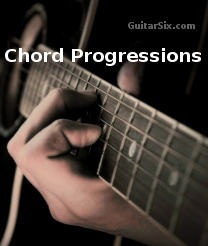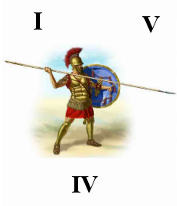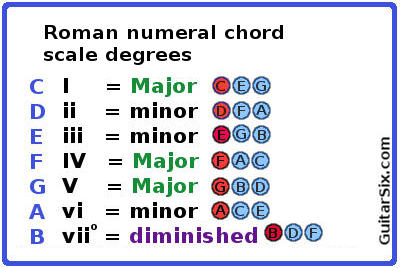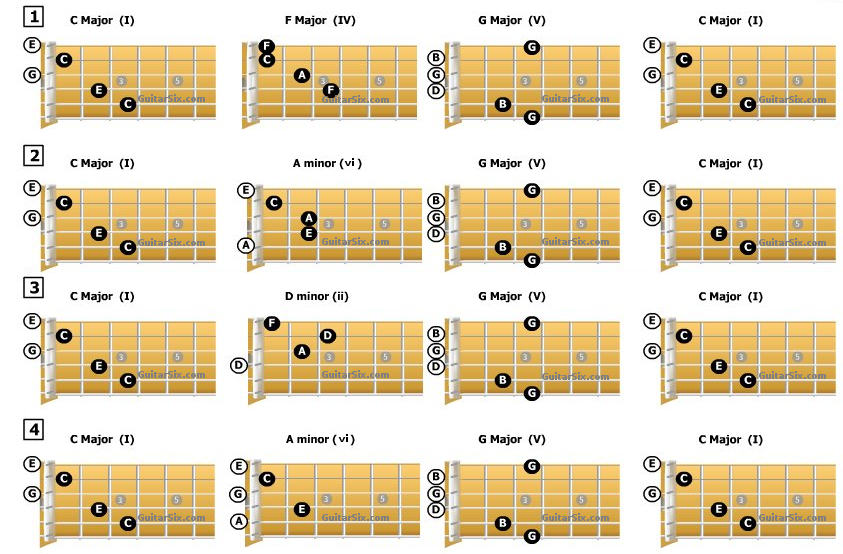Guitar Chord Progressions For Beginners

What are chord progressions?
A chord progression is the sequence of chords used to make music. In this long but informative lesson I go over everything you need to understand the basics of chord progressions.
The Roman Numeral System

In order to talk about progressions you have to know your Roman Numerals. The Roman Numeral System is a simple system of identifying chords in terms of their position on a scale degree (see scales). It is commonly used to discuss chords and chord progressions. Only Roman Numerals 1-7 are used For example: I, II, III, IV, V, VI, VII.
Uppercase Roman numerals are for chords that are Major chords. Lowercase is used for minor and diminished chords. The table below should clarify what the actual numbers are and what the scale degree is that they represent.
The seven Roman Numerals and their respective scale degrees are:
I or i = 1II or ii = 2
III or iii = 3
IV or iv = 4
V or v = 5
VI or vi = 6
VII or vii = 7
A Roman numeral applied to each of the seven diatonic scale degrees offers the reader a visual indication of not only it's position but also the type of chord. The Roman Numerals can also be combined with other symbols as well to help better describe the chord (as you will see later).
Pictured below are the triads built on each degree of a C Major scale and numbered with Roman numerals.

Or a more graphical representation....

In the graphic above you can see that each chord built on a particular scale degree is now numbered with an upper or lower case Roman numeral. Again, upper case numerals represent Major chords and lower case for all the other chord types. It's easy to remember what degree has what type Roman numeral due to the fact that there are only three Major chords in a Major scale and that they fall on the I, IV and V positions. So they are all upper case. All chords on the remaining scale degrees use lower case Roman numerals. The I IV V chord progression, is also one of the most basic chord progressions used in Rock music which you will learn more about later.
Roman numerals for minor scales
The Roman numeral system works for the Relative Natural minor scale too. Compare it to the Major scale and you can see how they relate numerically. The Roman numerals for a minor scale are as follows:
i , ii, III, iv, v, VI, VII.

Notice that the Major and it's relative minor scales have the same exact chords. The numbers are in a different order based on their position in the respective scale.
The music theory names for the Roman Numeral chord positions
You could live your whole guitar life not ever knowing this next bit of information. I just put it here for those that may be interested. You can safely skip to the next section if you want. Anyway, in music theory, each chord built on a specific scale degree also has a name and a type. Types follow the name and are "primary" for uppercase Roman Numerals or "secondary" for lower case. See below in the key of C and A minor.
Key of C Major
I = C Tonic (primary)
ii = D Supertonic (secondary)
iii = E Mediant (secondary)
IV = F Sub-Dominant (primary)
V = G Dominant (primary)
vi = A Submediant (secondary)
vii = B Subtonic or Leading Tone (secondary)
= B Subtonic or Leading Tone (secondary)
Key of A minor (relative minor)
i = A Tonic (primary)
ii = B Supertonic (secondary)
= B Supertonic (secondary)
III = C Mediant (secondary)
iv = D Sub-Dominant (primary)
v = E Dominant (primary)
VI = F Submediant (secondary)
VII = G Subtonic (secondary)
The names as well as the primary or secondary types are the same for Major and minor scales. But notice that the primary types for a Major scale are all Major chords and the primary types for a minor scale are minor chords. Remember lower case Roman Numerals are minor while uppercase are Major.
Chords that are primary, the I(i), IV(iv) and V(v) are called primary due to their importance in tonal harmony.
Using Roman Numerals to indicate chord progressions
Now that you have some knowledge of the Roman Numeral System under your belt, we can use them as symbols to represent chords in chord progressions.
Since a chord progression is simply the movement from one chord to another in a series of chords the combinations are almost endless. It is impossible to list every type of chord progression. We can however, cover some of the more common progressions.

Chord progression examples
Basic Rock Progression
The I IV V I progression is so common that that we will cover it first in the key of C.
In the key of C Major if we take the I, IV, V, I chords we would get three major chords ordered like:
C F G C
I IV V I
Many songs have been written using this progression or variations of it due to 1) it's very basic and effective nature and 2) it's strong resolution to the Tonic (I) of the scale which gives a definite tonal focus and establishment of key. The strong resolution is caused by the move from the V chord back to the I which is called a "Perfect" cadence.
A progression from the IV chord to I chord is known as a plagal cadence and it too is used in many popular songs.
Example progressions with open guitar chords
Here are some more basic chord progression examples that use open position chords to get you started.

A list of 2, 3, 4, and 5 chord progressions
Like I said before, there are endless possibilities of progressions but here is a list of more to try. Try them in different keys as well as minor keys too.
2 Chord progressions
I IV example - C/F
I V example - C/G
You get the idea....try various two chord combos.
3 Chord Progressions
I IV V example - C/F/G
I IV V7 example - C/F/G7
I iii IV example - C/Em/G
I ii IV example - C/Dm/F
ii V I example - Dm/G/C
4 Chord Progressions
I IV I V example - C/F/C/G
I IV I V7 example - C/F/C/G7
I V IV V example - C/G/F/G
I IV V I example - C/F/G/C
I IV V IV example - C/F/G/F
I vi V IV example - C/Am/G/F
I vi IV V example - C/Am/F/G
I V vi IV example - C/G/Am/F
I vi ii V example - C/Am/Dm/G
I vi ii V7 example - C/Am/Em/G7
I vi iii IV example - C/Am/Em/F
I iii vi IV example - C/Em/Am/F
IV I IV V example - F/C/F/G
vi IV I V example - Am/F/C/G
I VI IV V example - C/A/F/G
ii V I vi example - Dm/G/C/Am
5 Chord Progressions
I vi ii IV V7 example - C/Am/Dm/F/G7
I vi ii V7 ii example - C/Am/Dm/G7/Dm
I ii iii IV V example - C/Dm/Em/F/G
I ii vi V I example - C/Dm/Am/G/C
I vi ii V I example - C/Am/Dm/G/C
I iii vi V I example - C/Em/Am/G/C
Jazz chord progressions
Jazz music uses 7th and 9th chords. So try the progressions above using 7th and 9th chords if you are into Jazz.
Summary
Experiment making your own progressions using the chords that naturally occur within a scale. Use the Roman Numeral system as your guide. Use C Major/A minor as the key and the Roman numerals to figure out what type of chords to play (you can change keys later). Experiment with different rhythms to your progression too. For instance play the I chord for two beats then the iii chord for two beats, then the IV chord for four beats and then the V chord for four beats followed by the I chord for four beats. Anything goes so be creative. Who knows, you might just create a progression for a hit song!
Posted November 30, 2015, 7:17 pm in: Guitar lessons
Share a link to this guitar lesson with your friends (right click Permalink > copy or mobile long press > copy)



